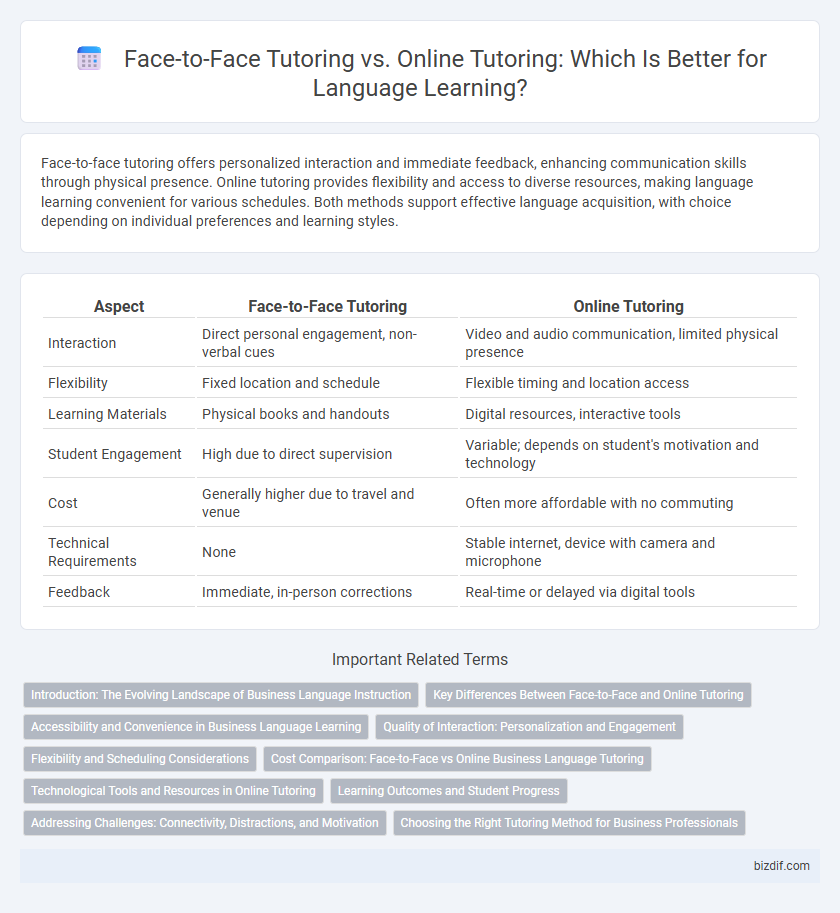Face-to-face tutoring offers personalized interaction and immediate feedback, enhancing communication skills through physical presence. Online tutoring provides flexibility and access to diverse resources, making language learning convenient for various schedules. Both methods support effective language acquisition, with choice depending on individual preferences and learning styles.
Table of Comparison
| Aspect | Face-to-Face Tutoring | Online Tutoring |
|---|---|---|
| Interaction | Direct personal engagement, non-verbal cues | Video and audio communication, limited physical presence |
| Flexibility | Fixed location and schedule | Flexible timing and location access |
| Learning Materials | Physical books and handouts | Digital resources, interactive tools |
| Student Engagement | High due to direct supervision | Variable; depends on student's motivation and technology |
| Cost | Generally higher due to travel and venue | Often more affordable with no commuting |
| Technical Requirements | None | Stable internet, device with camera and microphone |
| Feedback | Immediate, in-person corrections | Real-time or delayed via digital tools |
Introduction: The Evolving Landscape of Business Language Instruction
Business language instruction has transformed with the rise of online tutoring platforms, offering learners flexible access to diverse language resources. Face-to-face tutoring remains valued for its personalized interaction and immediate feedback, fostering deeper conversational skills. Both methods integrate advanced technologies and tailored curricula to meet the growing demand for effective, professional language acquisition.
Key Differences Between Face-to-Face and Online Tutoring
Face-to-face tutoring offers real-time, in-person interaction facilitating immediate feedback and non-verbal communication cues essential for language acquisition. Online tutoring provides flexible scheduling, diverse digital resources, and access to tutors worldwide, enabling personalized learning environments. Key differences include physical presence, communication dynamics, and technological integration, directly impacting engagement and instructional methods.
Accessibility and Convenience in Business Language Learning
Online tutoring offers unparalleled accessibility for business language learners, removing geographical barriers and enabling flexible scheduling across different time zones. Face-to-face tutoring provides personalized interaction and immediate feedback, enhancing communication skills crucial in professional environments. Both methods cater to varying convenience needs, with online platforms allowing self-paced study and face-to-face sessions promoting focused, distraction-free learning.
Quality of Interaction: Personalization and Engagement
Face-to-face tutoring offers a higher quality of interaction through personalized, real-time feedback and nonverbal communication cues that enhance engagement and understanding. Online tutoring leverages digital tools and interactive platforms to provide customized learning experiences, yet it may lack the immediacy and nuanced interpersonal connection found in physical settings. Effective tutoring balances personalized content delivery with active student participation to maximize learning outcomes.
Flexibility and Scheduling Considerations
Face-to-face tutoring offers fixed scheduling and location constraints, which can limit flexibility for students with busy or unpredictable timetables. Online tutoring provides more adaptable scheduling options, allowing learners to choose sessions that fit their availability, including evenings and weekends. This flexibility supports personalized learning rhythms and immediate adjustments to tutoring times, enhancing overall accessibility and convenience.
Cost Comparison: Face-to-Face vs Online Business Language Tutoring
Face-to-face business language tutoring typically incurs higher costs due to expenses like travel, venue rental, and printed materials, averaging $40 to $70 per hour. In contrast, online tutoring offers a more economical solution, with prices ranging from $20 to $40 per hour, enabled by lower overhead and digital resources. The cost efficiency of online business language tutoring makes it a preferred option for many professionals seeking flexible and budget-friendly language instruction.
Technological Tools and Resources in Online Tutoring
Online tutoring leverages advanced technological tools such as interactive whiteboards, real-time video conferencing, and AI-powered language learning apps to create immersive and personalized learning experiences. These resources facilitate instant feedback, access to a vast array of digital materials, and the ability to track progress through analytics. Compared to face-to-face tutoring, the integration of technology enhances flexibility and provides diverse multimedia content that supports varied learning styles and accelerates language acquisition.
Learning Outcomes and Student Progress
Face-to-face tutoring offers personalized interaction that enhances immediate feedback and adaptive teaching strategies, often leading to higher retention rates and accelerated student progress. Online tutoring provides flexible scheduling and access to diverse digital resources, supporting individualized learning pace and consistent performance tracking through analytics. Research shows that combining both methods can optimize learning outcomes by leveraging the strengths of direct engagement and technological support.
Addressing Challenges: Connectivity, Distractions, and Motivation
Face-to-face tutoring provides a controlled environment that minimizes connectivity issues and reduces distractions, enhancing student focus and engagement. Online tutoring faces challenges such as unstable internet connections and increased distractions from home environments, which can hinder motivation and learning outcomes. Effective online tutoring strategies include interactive platforms and structured schedules to maintain motivation and address connectivity problems.
Choosing the Right Tutoring Method for Business Professionals
Business professionals often benefit more from face-to-face tutoring, which allows personalized interaction and immediate feedback tailored to industry-specific language skills. Online tutoring offers flexibility and access to specialized instructors worldwide, making it ideal for busy schedules and diverse business communication needs. Selecting the right method depends on prioritizing real-time interaction versus convenience and global expertise in language instruction.
Face-to-face tutoring vs Online tutoring Infographic

 bizdif.com
bizdif.com